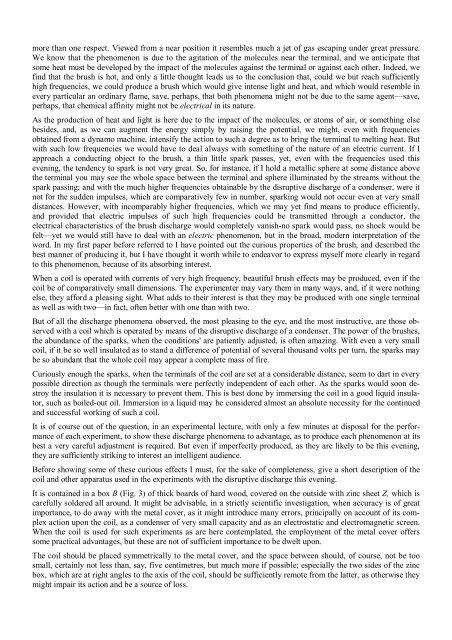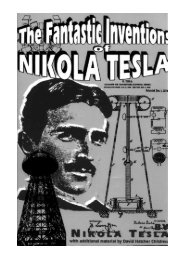the fantastic inventions of nikola tesla - Exopolitics Hong Kong
the fantastic inventions of nikola tesla - Exopolitics Hong Kong
the fantastic inventions of nikola tesla - Exopolitics Hong Kong
Create successful ePaper yourself
Turn your PDF publications into a flip-book with our unique Google optimized e-Paper software.
more than one respect. Viewed from a near position it resembles much a jet <strong>of</strong> gas escaping under great pressure.<br />
We know that <strong>the</strong> phenomenon is due to <strong>the</strong> agitation <strong>of</strong> <strong>the</strong> molecules near <strong>the</strong> terminal, and we anticipate that<br />
some heat must be developed by <strong>the</strong> impact <strong>of</strong> <strong>the</strong> molecules against <strong>the</strong> terminal or against each o<strong>the</strong>r. Indeed, we<br />
find that <strong>the</strong> brush is hot, and only a little thought leads us to <strong>the</strong> conclusion that, could we but reach sufficiently<br />
high frequencies, we could produce a brush which would give intense light and heat, and which would resemble in<br />
every particular an ordinary flame, save, perhaps, that both phenomena might not be due to <strong>the</strong> same agent—save,<br />
perhaps, that chemical affinity might not be electrical in its nature.<br />
As <strong>the</strong> production <strong>of</strong> heat and light is here due to <strong>the</strong> impact <strong>of</strong> <strong>the</strong> molecules, or atoms <strong>of</strong> air, or something else<br />
besides, and, as we can augment <strong>the</strong> energy simply by raising <strong>the</strong> potential, we might, even with frequencies<br />
obtained from a dynamo machine, intensify <strong>the</strong> action to such a degree as to bring <strong>the</strong> terminal to melting heat. But<br />
with such low frequencies we would have to deal always with something <strong>of</strong> <strong>the</strong> nature <strong>of</strong> an electric current. If I<br />
approach a conducting object to <strong>the</strong> brush, a thin little spark passes, yet, even with <strong>the</strong> frequencies used this<br />
evening, <strong>the</strong> tendency to spark is not very great. So, for instance, if I hold a metallic sphere at some distance above<br />
<strong>the</strong> terminal you may see <strong>the</strong> whole space between <strong>the</strong> terminal and sphere illuminated by <strong>the</strong> streams without <strong>the</strong><br />
spark passing; and with <strong>the</strong> much higher frequencies obtainable by <strong>the</strong> disruptive discharge <strong>of</strong> a condenser, were it<br />
not for <strong>the</strong> sudden impulses, which are comparatively few in number, sparking would not occur even at very small<br />
distances. However, with incomparably higher frequencies, which we may yet find means to produce efficiently,<br />
and provided that electric impulses <strong>of</strong> such high frequencies could be transmitted through a conductor, <strong>the</strong><br />
electrical characteristics <strong>of</strong> <strong>the</strong> brush discharge would completely vanish-no spark would pass, no shock would be<br />
felt—yet we would still have to deal with an electric phenomenon, but in <strong>the</strong> broad, modern interpretation <strong>of</strong> <strong>the</strong><br />
word. In my first paper before referred to I have pointed out <strong>the</strong> curious properties <strong>of</strong> <strong>the</strong> brush, and described <strong>the</strong><br />
best manner <strong>of</strong> producing it, but I have thought it worth while to endeavor to express myself more clearly in regard<br />
to this phenomenon, because <strong>of</strong> its absorbing interest.<br />
When a coil is operated with currents <strong>of</strong> very high frequency, beautiful brush effects may be produced, even if <strong>the</strong><br />
coil be <strong>of</strong> comparatively small dimensions. The experimenter may vary <strong>the</strong>m in many ways, and, if it were nothing<br />
else, <strong>the</strong>y afford a pleasing sight. What adds to <strong>the</strong>ir interest is that <strong>the</strong>y may be produced with one single terminal<br />
as well as with two—in fact, <strong>of</strong>ten better with one than with two.<br />
But <strong>of</strong> all <strong>the</strong> discharge phenomena observed, <strong>the</strong> most pleasing to <strong>the</strong> eye, and <strong>the</strong> most instructive, are those observed<br />
with a coil which is operated by means <strong>of</strong> <strong>the</strong> disruptive discharge <strong>of</strong> a condenser. The power <strong>of</strong> <strong>the</strong> brushes,<br />
<strong>the</strong> abundance <strong>of</strong> <strong>the</strong> sparks, when <strong>the</strong> conditions' are patiently adjusted, is <strong>of</strong>ten amazing. With even a very small<br />
coil, if it be so well insulated as to stand a difference <strong>of</strong> potential <strong>of</strong> several thousand volts per turn, <strong>the</strong> sparks may<br />
be so abundant that <strong>the</strong> whole coil may appear a complete mass <strong>of</strong> fire.<br />
Curiously enough <strong>the</strong> sparks, when <strong>the</strong> terminals <strong>of</strong> <strong>the</strong> coil are set at a considerable distance, seem to dart in every<br />
possible direction as though <strong>the</strong> terminals were perfectly independent <strong>of</strong> each o<strong>the</strong>r. As <strong>the</strong> sparks would soon destroy<br />
<strong>the</strong> insulation it is necessary to prevent <strong>the</strong>m. This is best done by immersing <strong>the</strong> coil in a good liquid insulator,<br />
such as boiled-out oil. Immersion in a liquid may be considered almost an absolute necessity for <strong>the</strong> continued<br />
and successful working <strong>of</strong> such a coil.<br />
It is <strong>of</strong> course out <strong>of</strong> <strong>the</strong> question, in an experimental lecture, with only a few minutes at disposal for <strong>the</strong> performance<br />
<strong>of</strong> each experiment, to show <strong>the</strong>se discharge phenomena to advantage, as to produce each phenomenon at its<br />
best a very careful adjustment is required. But even if imperfectly produced, as <strong>the</strong>y are likely to be this evening,<br />
<strong>the</strong>y are sufficiently striking to interest an intelligent audience.<br />
Before showing some <strong>of</strong> <strong>the</strong>se curious effects I must, for <strong>the</strong> sake <strong>of</strong> completeness, give a short description <strong>of</strong> <strong>the</strong><br />
coil and o<strong>the</strong>r apparatus used in <strong>the</strong> experiments with <strong>the</strong> disruptive discharge this evening.<br />
It is contained in a box B (Fig. 3) <strong>of</strong> thick boards <strong>of</strong> hard wood, covered on <strong>the</strong> outside with zinc sheet Z, which is<br />
carefully soldered all around. It might be advisable, in a strictly scientific investigation, when accuracy is <strong>of</strong> great<br />
importance, to do away with <strong>the</strong> metal cover, as it might introduce many errors, principally on account <strong>of</strong> its complex<br />
action upon <strong>the</strong> coil, as a condenser <strong>of</strong> very small capacity and as an electrostatic and electromagnetic screen.<br />
When <strong>the</strong> coil is used for such experiments as are here contemplated, <strong>the</strong> employment <strong>of</strong> <strong>the</strong> metal cover <strong>of</strong>fers<br />
some practical advantages, but <strong>the</strong>se are not <strong>of</strong> sufficient importance to be dwelt upon.<br />
The coil should be placed symmetrically to <strong>the</strong> metal cover, and <strong>the</strong> space between should, <strong>of</strong> course, not be too<br />
small, certainly not less than, say, five centimetres, but much more if possible; especially <strong>the</strong> two sides <strong>of</strong> <strong>the</strong> zinc<br />
box, which are at right angles to <strong>the</strong> axis <strong>of</strong> <strong>the</strong> coil, should be sufficiently remote from <strong>the</strong> latter, as o<strong>the</strong>rwise <strong>the</strong>y<br />
might impair its action and be a source <strong>of</strong> loss.









